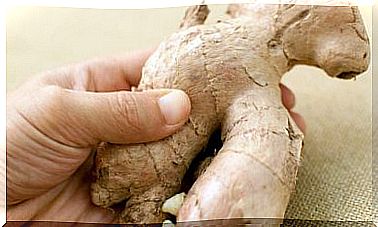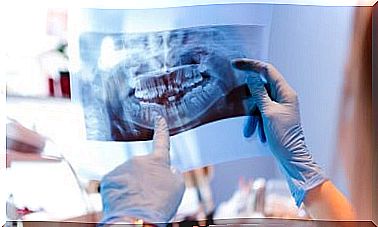7 Stretches That Will Help You If You Have Low Back Pain
Stretches are part of the treatment for low back pain. In addition to alleviating pain, they take care of muscle health. Know 7 stretches that will help you if you have low back pain.

There are a number of helpful stretches for low back pain, characterized by a dull ache in the lower back, between the last rib and the lower buttock area. On some occasions, the ailment can extend to the legs.
When it occurs for a period of no more than three months, it is called acute . If the pain persists after this time, it can be referred to as chronic low back pain . In both cases it brings complications in the lives of those who suffer from it. For this reason, it is essential to treat it through body stretching.
Causes of low back pain
Identifying the exact source of low back pain can be difficult. An article published in the Medical Clinics of North America details the possible causes of low back pain. These are some:
- Wear: by friction between the vertebrae of the spine.
- Herniated discs: they are protrusions of the lumbar disc between the vertebrae.
- Compression: of the nerves as they emerge from the spinal cord.
- Scoliosis: a deviation of the axis of the back.
- Traumas: We include a large number of situations here, from ligament tears to accidents or noxious forces, poor movement and improper posture.
Low back pain can be treated with medications, physical therapies, and specific stretches to improve back flexibility. In severe cases, surgery is recommended by specialist doctors to relieve pain.

How do stretching help if you have low back pain?
If you have low back pain, the importance of stretching is to prevent your back muscles from atrophying or weakening. Despite the pain that moving can cause, rest is not recommended in these cases.
A study published in the Public Health Journal confirms that treatments that involve physical activity reduce the intensity of pain and the possibility of needing medical disability.
According to the National Institute of Neurological Disorders and Cardiovascular Accidents, a person’s condition affects low back pain. Lower back ailments are more common in those who do not practice moderate physical activity, as the muscles of their back and abdomen are not strong enough to support the spine.
Staying inactive is bad for your back, affecting joint cartilage, spinal tissues, and muscle strength. To treat low back pain and other conditions such as osteoarthritis, physical exercise and stretching seem to be necessary.
7 stretches to ease back pain
The stretching exercises for low back pain presented below can reduce muscle stiffness, improve flexibility of the tendons and ligaments in the back, as well as increase range of motion in the spine and relieve pain.
It is important to do them regularly to take care of the lower back. However, if the pain seems to be getting worse, take a break and see your specialist doctor. Read carefully and get ready to stretch!
1. Sphinx stretch
Doing this stretch if you have low back pain makes it easier to extend your lower back, strengthen your glutes, and relax your lower back:
- Lie face down with your pelvis flat against the floor. The arms are located below the shoulders, the palms of the hands are open and the legs are apart.
- Keeping your pelvis on the floor, stretch your back while pressing your hands toward the floor. The gaze should be directed to the front.
- Stay in this position for 10 seconds.
- When finished, rest and resume the stretch for 5 repetitions.
2. Stretching for spinal mobility
To improve the flexibility of the spine and soothe lower back pain, this simple stretch seems to be very useful:
- Begin by sitting on a towel or blanket to release tension on your back. Your legs should be crossed and your hands on your knees.
- Taking a deep breath, push your chest out and gently pull it forward without moving your buttocks. This exercise should not cause pain. Stay in this position for 10 seconds.
- Next, exhale and round your back by gently pushing it back as far as you can.
- Perform 5-10 repetitions slowly and with deep breaths.
This spinal arch exercise can also be done in the four-brace position, with hands under the shoulders and knees under the hips. With this modification in posture, it becomes the cat stretch .
3. Knees to chest
In addition to reducing low back pain, stretching the hip flexors helps us complete daily activities that require lumbar movement, such as bending over or lifting objects. We will do a simple hip flexion, bringing the knees to the chest. This will allow us to work the gluteal area:
- Start by lying on your back with your knees bent and your feet flat on the floor.
- Take a breath while bringing your right leg to your chest while maintaining the curvature of your lumbar spine.
- Then bring your left leg up to your chest.
- Place your hands behind your thighs to support both legs above your chest. Take 5 deep breaths.
- When finished, stretch one leg at a time, bringing it to the ground so that it is flexed as in the initial position.

4. Stretching the muscles of the lower back
This stretch is very effective in relieving lower back pain, provided it is done correctly:
- Lying on your back, with your legs stretched out on the floor, bend your right leg bringing it to your chest.
- Once there, place the ankle on the thigh of the opposite leg with the help of the left hand. The stretch should be felt in the tissues of the lower back.
- Hold this position for 10 seconds before repeating the exercise with your left leg.
- Do this stretch 5 more times.
5. Stretch alternating arms and legs
Alternate arm and leg raises in the four-brace position work your back muscles, glutes, and coordination. According to an article published in Work magazine , this stretch maintains tension on the muscles of the abdomen, which has a positive effect on the spine.
To do this, it is important that the spine is aligned with the head and that it remains firm. Try not to bend your hips:
- Start in all fours position, hands under shoulders and knees under hips.
- Contract your abdominal muscles.
- Taking care that the torso remains firm, raise the right leg and keep it straight. At the same time, raise your left arm.
- Hold this position for 5 seconds.
- Do the same exercise with the left leg and the opposite arm.
6. Pelvic elevation
In addition to stretching the lower back, this exercise also strengthens it. It is done as follows:
- Begin by lying on your back with your legs bent, your feet flat on the floor, and your arms stretched out on each side of your body with your palms open.
- Contract your abdominal and gluteal muscles.
- In this position, raise your pelvis. A line should be formed from the trunk to the thighs. The hands and feet remain on the ground.
- Make sure that your neck stays relaxed on the ground and remains in this position for 5 seconds, breathing slowly.
- Lower your hips and torso to the floor to rest.

7. Stabilization of the spine
Lumbo-pelvic stabilization is suggested for the treatment of low back pain. Although it is not yet clear the number of repetitions or appropriate duration to get the most out of this exercise, it is recommended to practice it regularly as follows:
- Begin lying on your back, arms extended on each side of the body and the right leg bent with the foot resting on the floor.
- Contract your abdominal and gluteal muscles.
- Next, raise your left leg with your knee extended as far as you can. Press your hands against the floor to help you complete the stretch.
- Hold this position for 5 seconds.
- Lower your right leg and rest. Then repeat the stretch with the opposite leg.
Exercises within the framework of a healthy life
There is no specific stretching routine if you have low back pain, however, these exercises will help relieve pain as long as you do them regularly. You can choose two of them in each day.
If you have doubts about the best treatment for you, consult a specialized professional for an accurate diagnosis. Remember that lumbar health begins with adopting good posture, walking, and taking time to be physically active.









